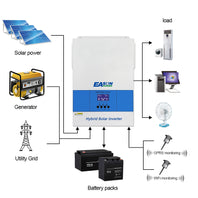When it comes to harnessing solar energy, choosing the right solar battery regulator is crucial for ensuring maximum efficiency and safety. A solar battery regulator, also known as a charge controller, is responsible for regulating the voltage and current from solar panels to the battery to prevent overcharging and ensure optimal charging. In this article, we will delve into the key factors to consider when selecting a solar battery regulator to maximize efficiency and safety.

Understanding the Types of Solar Battery Regulators
There are two main types of solar battery regulators: PWM (Pulse Width Modulation) and MPPT (Maximum Power Point Tracking). PWM regulators are more affordable and are suitable for smaller solar systems with a lower voltage. On the other hand, MPPT regulators are more efficient and can handle higher voltage systems, making them ideal for larger installations. Understanding the specific requirements of your solar system is essential in choosing the right type of regulator for maximum efficiency and safety.
Consider the Voltage and Current Ratings
When selecting a solar battery regulator, it is crucial to consider the voltage and current ratings to ensure compatibility with your solar panels and battery bank. The regulator's voltage rating should match the maximum voltage output of the solar panels, while the current rating should be able to handle the maximum current output. Choosing a regulator with the appropriate voltage and current ratings is essential for optimizing the charging process and preventing overcharging, thereby ensuring the safety and longevity of the battery.
Overcharge Protection and Safety Features
One of the most critical aspects of choosing a solar battery regulator is ensuring that it provides overcharge protection and other safety features. Overcharging can lead to reduced battery life and even pose safety hazards. Look for regulators with features such as overcharge protection, temperature compensation, and reverse polarity protection to safeguard the battery and the overall solar system. Prioritizing safety features is paramount in selecting a regulator for maximum efficiency and safety.
Efficiency and Monitoring Capabilities
Efficiency is a key factor in maximizing the energy output of a solar system. MPPT regulators are known for their high efficiency in converting solar energy into usable power, making them an excellent choice for larger installations. Additionally, some regulators come with monitoring capabilities, allowing users to track the performance of the solar system and identify any potential issues. Choosing a regulator with high efficiency and monitoring capabilities can significantly enhance the overall efficiency and safety of the solar system.
In conclusion, choosing the right solar battery regulator is essential for achieving maximum efficiency and safety in a solar system. By understanding the types of regulators, considering voltage and current ratings, prioritizing overcharge protection and safety features, and focusing on efficiency and monitoring capabilities, users can make informed decisions to optimize their solar energy setup. With the right solar battery regulator in place, users can harness the full potential of solar energy while ensuring the safety and longevity of their solar system.








